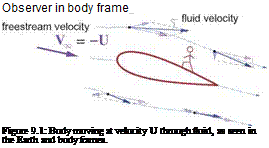Introduction to Flight Dynamics
This chapter will treat the key concepts and formulations used in the discipline of flight dynamics and control. The primary focus here will be on the aerodynamic characterization of the aircraft, as required for flight dynamics applications. For a complete treatment of the subject, see Etkin [65] and Nelson [66].
9.1 Frames of Reference
Description of body or fluid positions, velocities, and rotation rates requires a frame of reference for these quantities. For unsteady aerodynamics and flight dynamics, two distinct frames of reference are useful:
• An inertial “Earth” frame, either fixed to the Earth or translating uniformly relative to the Earth.
• The non-inertial “body” frame, typically fixed to the aerodynamic body of interest.
Figure 9.1 illustrates the distinction between the two frames. For steady aerodynamics the body frame is most natural, although the Earth (or airmass) frame is also useful as in the case of Trefftz-plane theory treated in Chapter 5. For unsteady aerodynamics the Earth frame is more natural because it is inertial.
 |
Observer in earth frame











